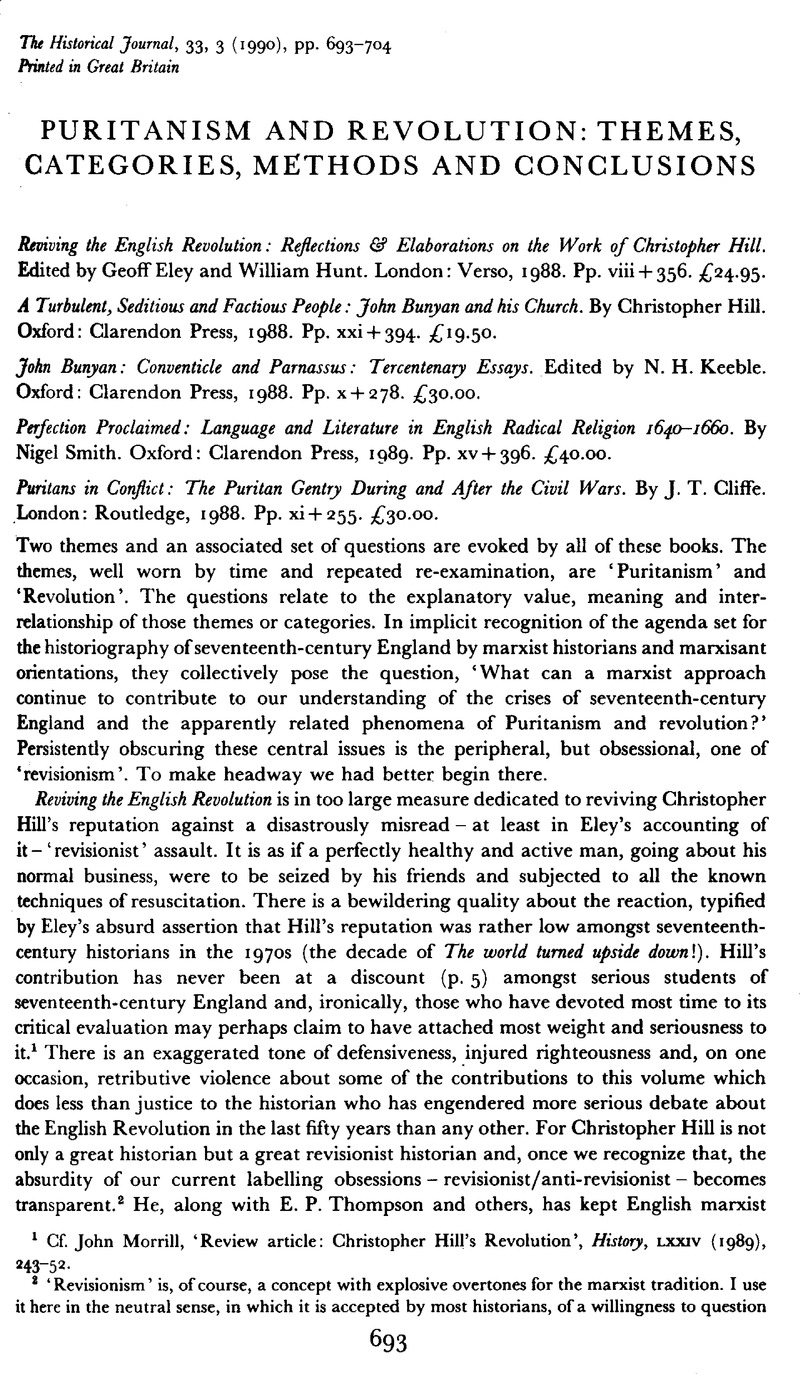Article contents
Puritanism and Revolution: Themes, Categories, Methods and Conclusions
Published online by Cambridge University Press: 11 February 2009
Abstract

- Type
- Review Articles
- Information
- Copyright
- Copyright © Cambridge University Press 1990
References
1 Cf. Morrill, John, ‘Review article: Christopher Hill's Revolution’, History, LXXIV (1989), 243–52CrossRefGoogle Scholar.
2 ‘Revisionism’ is, of course, a concept with explosive overtones for the marxist tradition. I use it here in the neutral sense, in which it is accepted by most historians, of a willingness to question and, where necessary, discard received accounts. For some salutary remarks on revisionism/anti-revisionism in Stuart historiography see Glenn Burgess, ‘On Revisionism: an analysis of early Stuart historiography in the 1970s and 1980s’, Historical Journal (forthcoming).
3 Eley, and Hunt, (eds.), Reviving, pp. 337–9Google Scholar. Cf. the points made by Barry Reay, ibid. pp. 61–6.
4 Possibly, like the Ranters?
5 Hill, , Turbulent, seditious and factious people, p. 322Google Scholar. Cf. pp. 40, 107, 150–1, 332, 368–9, 373.
6 White, B. R., ‘The fellowship of believers: Bunyan and Puritanism’, in Keeble, (ed.), Bunyan, p. 3Google Scholar.
7 Hill, Christopher, The world turned upside down: radical ideas during the English Revolution (Harmondsworth, 1975), ch. 8Google Scholar.
8 The heavenly footman in The miscellaneous works of John Bunyan, ed. Sharrock, Roger (Oxford, 1976– ), V, 158–61Google Scholar.
9 Rivers, , ‘Grace, holiness and the pursuit of happiness: Bunyan and restoration latitudinarianism’, in Keeble, (ed.), Bunyan, p. 68Google Scholar. The quotation is from The strait gate (1676).
10 It also seems to me that the assertion that Bunyan is in some sense transferring traditional oral culture to the printed page will not bear the close scrutiny that the former is coming under in the work-in-progress of scholars like David Rollison. Cf. Sharrock, Roger, ‘“When at the first I took my Pen in hand”. Bunyan and the Book’ in Keeble, (ed.), Bunyan, pp. 73, 75, 76Google Scholar.
11 Keeble, (ed.), Bunyan, pp. 1, 111, 171Google Scholar. Kaufmann's reading of Calvin (and Bunyan) on providence should be set against van der Mollen, Ronald J., ‘Providence as mystery, providence as revelation: Puritan and Anglican modifications of John Calvin's Doctrine of Providence’, Church History, XLVII (1978), 27–47CrossRefGoogle Scholar.
12 Hill, , Turbulent, seditious and factious people, p. 337Google Scholar. Hill, is quoting from A confession of my faith (1672)Google Scholar.
13 White, , ‘Bunyan and Puritanism’, in Keeble, (ed.), Bunyan, p. 8Google Scholar. White, is quoting Tibbutt, H. G. (ed.), The minutes of the first independent church (now Bunyan meeting) at Bedford, 1656–1766, Publications of the Bedfordshire Historical Record Society, 55 (Bedford, 1976) pp. 17, 19Google Scholar.
14 Cf. Hill's remarks on Bunyan's attitude to Paul Hobson's ecumenicity. Hill, , Turbulent, saditious and factious people, p. 55Google Scholar.
15 Cf. Davis, J. C., ‘Cromwell's religion’, in Morrill, John (ed.), Oliver Cromwell and the English Revolution (Harlow, 1990)Google Scholar. It is instructive to note Christopher Hill's comments on the Bedford Congregation's apparent pragmatism about its own designation well into the eighteenth century. Hill, , Turbulent, seditious and factious people, pp. 293–4Google Scholar.
16 Cf. Davis, J. C., ‘Radical lives’, Political Science, XXXVII (1985), 166–72CrossRefGoogle Scholar.
17 Smith, , Perfection proclaimed, p. 7 n. 17Google Scholar. For a recent review of ‘distinctions’ between Presbyterians and Independents on the issue of religious toleration see Zakai, Avilu, ‘Religious toleration and its enemies: the Independent Divines and the issue of toleration during the English Civil War’, Albion, XXI (1989), 1–33CrossRefGoogle Scholar.
18 See Condren, Conal, ‘Radicals, Conservatives and Moderates in early modern political thought: a case of Sandwich Islands syndrome’, History of Political Thought, X (1989), 525–42Google Scholar.
19 Holstun, James, A rational millennium: Puritan utopias of seventeenth century England & America (New York, 1987)Google Scholar.
20 See Smith, , Perfection proclaimed, ch. 1 especially, pp. 61–72Google Scholar, and for self-denial and the reconstruction of the self, p. 66.
21 Ibid. pp. 36, 47, 49, 54, 151, 156, 193, 269.
23 Ibid. pp. 11, 347–8. Compare the claim that women ‘made a significant impact upon society from within the radical religious field’ (p. 12) with Phyllis Mack's caution about allowing that any radicals – other than Quakers – even temporarily broke free of patriarchalism.
24 Cliffe, J. T., The Puritan gentry: The great Puritan families of early Stuart England (London, 1984)Google Scholar.
25 Of course the proportions of the parliamentary gentry who were Puritans are much higher: 65 per cent in 1643, 73 Per cen in 1645.
- 1
- Cited by


